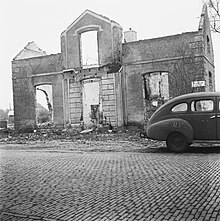Case putti
The case Putten was a war crimes during the Second World War that the German Wehrmacht on October 2, 1944 in the Dutch town of Putten committed. 661 men from the village were deported to various concentration camps, 612 of whom perished there. The remaining population had to leave the village, which was then partially destroyed by the Wehrmacht.
Course of events
After Dutch partisans shot at four German officers in a car on the night of October 1, 1944 and one of them was killed, General der Flieger Friedrich Christiansen , the then Wehrmacht commander- in- chief in the Netherlands, ordered them on October 2, 1944 660 Putten men aged 17 and over were captured in a major raid and initially deported to the Amersfoort camp. 59 of them were released there, then 601 men were deported to the Neuengamme concentration camp , 13 were able to jump out of the train on the way, so that 588 arrived in Neuengamme. From there, the Putten prisoners were sent to other concentration camps, especially the Neuengammes satellite camps .
The women, children and old people of the community had to leave the village and their houses were burned down. Over 100 buildings and apartments were destroyed. In the seven months leading up to the end of the war, most of the men captured and deported were killed in German concentration camps, 110 alone in the Ladelund concentration camp . Only 48 of the deportees returned to Putten after the liberation, and another five of them died as a result of their imprisonment in the concentration camp. Eight people were shot dead during the raid, including the only woman killed.
Work-up
After the war, the three most responsible military men Fritz Fullriede , Friedrich Christiansen and Heinz-Hellmuth von Wühlisch were convicted of war crimes by a Dutch court.
In honor of the victims, a memorial was erected in the center of the Putten community. It was inaugurated by Queen Juliana on October 1, 1949 . An exhibition on the history of the raid and panels with the names of the victims complement this facility in a memorial room opened in 1999.
In 1946, the Protestant pastor of the North Frisian village of Ladelund informed that 111 men from Putten had died in the Neuengamme subcamp there and had been buried on site. This resulted in a “work of reconciliation and remembrance that is unique for the Netherlands and Germany” by Putten and Ladelund. The events in Putten and the fate of the abducted persons were presented for the first time in an exhibition in 1981 and in 2015 as part of a special exhibition at the Neuengamme Concentration Camp Memorial .
In Wedel , a street and a plaque commemorates the war crime.
literature
Non-fiction
- Madelon de Keizer: Raid on putti. Wehrmacht crimes in a Dutch village. Translated from Dutch and edited by Stefan Häring. Dittrich Verlag, Cologne 2001, ISBN 3-920862-35-X .
- Madelon de Keizer: War crimes in the occupied Netherlands - The "Putten case". In: Wolfram Wette , Gerd R. Ueberschär (Ed.): War crimes in the 20th century. Primus-Verlag, Darmstadt 2001, ISBN 3-89678-417-X , pp. 259-273.
- Andreas Pflock: On forgotten tracks. A guide to memorials in the Netherlands, Belgium and Luxembourg. Federal Agency for Civic Education , Bonn 2006, ISBN 3-89331-685-X .
- Pieter Dekker and Gert van Dompseler, Van naam tot number. Slachtoffers van de Puttense raid, Leeuwaarden: Uitgeverij Louise 2014.
- Raimo Alsen, The Putten-Ladelund loop. A relay race in memory of the concentration camp victims, Grenzfriedenshefte 2/2015, pp. 149–160.
- Christine Gundermann, The Reconciled Citizens. The Second World War in German-Dutch encounters 1945–2000, Münster: Waxmann 2014.
Literary processing
- Dieter Alpheo Müller: And God will dry all tears. Story of a deportation. A documentary novel. Kiepenheuer & Witsch, Cologne 1983, ISBN 3-462-01526-5 .
- Licensed edition under the same title: Verlag Videel, Niebüll 2001, ISBN 3-89906-092-X .
Web links
- Information about the raid and today's memorial on the Internet platform Gedenken in BENELUX
- Website of the Stichting Oktober 44 (German Foundation October 44 ; Dutch, partly in German and English)
- Website of the Ladelund concentration camp memorial and meeting place
Individual evidence
- ↑ Katharina Hertz-Eichenrode: 'Retaliation actions' in Murat, Meensel-Kiezegem and Putten. In: Oliver von Wrochem (Ed.): Repressalien und Terror. Paderborn 2017, ISBN 978-3-506-78721-7 , p. 189.

